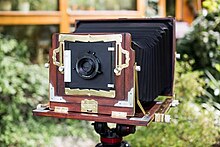Vageeswari camera

Vageeswari cameras were Indian large format cameras manufactured by Vageeshwari Camera Works.[2] They were the first field camera manufactured in India and were recognised globally. Vageeswari cameras were designed and manufactured by K. Karunakaran, an Alappuzha-based technician.[3][4]
Cameras were named after the goddess Saraswati. The first camera came with a price tag of Rs 250.[5] Leading photographers appreciated it for its impeccable accuracy and perfect quality. Many Japanese camera manufacturers copied Vageeshwari's models and designed field cameras.[2]
History
[edit]In 1942, Padmanabhan Nair, a photo studio owner, asked Kunju Kunju Bhagavathar, a musician, to fix his camera's torn bellows. Bhagavathar was able to fix it and Nair was suprised when he saw that camera worked better than ever before.[6] Nair then suggested Bhagavathar to make a camera but he declined. However his son, Karunakaran, took on the challenge. He started asking about the details of a camera and even travelled to Chennai, Bangalore and Mumbai to learn more about camera's working. He deconstructed an old camera and then put it back together.[7][8]
In 1946, Karunakaran finally built the first Vageeswari camera. It was on par with foreign cameras and its price was a fraction of foreign camera. They were an instant hit. The British officers bought Vageeswari cameras and took them home which caused the demand for camera to surge was in Britain and other colonial countries. Meanwhile, the license to import lenses from Japan and Germany was also obtained. Edward de Mello, an Anglo-Indian, was made of Head the international sales. He started shipping Vageeshwari cameras to Ceylon, Singapore, Malaysia, Nepal and Thailand.[2]
By 1950s, Karunakaran manufactured between 50-100 cameras per month and employed 30 people. By 1960s, he also got orders from Germany and Sri Lanka.[7][5] By 1980s, Vageeswari started becoming obsolete as the market started favouring compact cameras. As demand for cameras fell, Karunakaran diversified and started manufacturing other types of cameras.He designed a camera for the printing sector and one for the technical sector. In 1982, he created a camera for an ultrasound scanning machine. However, the diversification failed and in 1995, Vageeswari camera completely collapsed. The last Vageswari camera was made for called platinum photography.[9][2]
On 19 April 2016, K Karunakaran, aged 90, passed away.[10][9] The camera has seen a revival in attention.[11] In 2021, Lokame Tharavsdu exhibition, organized by Kochi Biennale Foundation, was held where Vageeswari cameras and photographs were showcased.[5][12][13] People like Satheesh Nair are now restoring Vageeswari cameras.[14] Today, Vageeswari cameras are found in various camera collections in Germany and England.[15]
Construction
[edit]The body was made of teak. Brass and aluminium knobs as well as Nettlefold screws held the frame together. German lenses were attached to a leather bellow. It took 18 hours to make one bellows. The cameras were entirely assembled by hand and Karunakaran attached the lens to the camera himself. Vageeswari used glass, which were imported from USA, coated with chemicals instead of films.[2]
Eight variants were produced that ranged from small cameras that took a maximum of four passport-size photos to a large 20 x 16 size camera.[16] He also manufactured fingerprint camera, panorama camera, camera for medical purposes and ultrasound scanner.[6]
See also
[edit]References
[edit]- ^ "Restoration of a Vageeswari View Camera – Fotografie". Christian Klant. 13 August 2014. Archived from the original on 2024-05-30. Retrieved 2016-04-20.
- ^ a b c d e Ali, Nawaz (2015-10-18). "സ്മൈല് പ്ലീസ്". Thejas News. Archived from the original on 2024-09-10. Retrieved 2024-09-10.
- ^ "The unsung hero who invented Vageeswari camera". ManoramaOnline. Archived from the original on 2016-04-22. Retrieved 2016-04-20.
- ^ Narayanan, Chitra (2021-08-18). "Turning the lens on the most iconic camera made in India". BusinessLine. Archived from the original on 2021-09-11. Retrieved 2024-05-28.
- ^ a b c Narayanan, Chitra (2021-08-19). "India's homegrown Vageeswari camera from Alappuzha". BusinessLine. Archived from the original on 2024-05-30. Retrieved 2024-05-28.
- ^ a b R, Krishna (2022-06-08). "ലോകത്തെ വിസ്മയിപ്പിച്ച വാഗീശ്വരി ക്യാമറയ്ക്ക് പിന്നില് ഒരു ആലപ്പുഴക്കാരന് ?". Archived from the original on 2024-09-10. Retrieved 2024-09-10.
- ^ a b Gupta, Nidhi. "Vageeswari: A made in India camera that left an impression". Croma Unboxed. Archived from the original on 2024-05-28. Retrieved 2024-05-28.
- ^ "വാഗീശ്വരി ക്യാമറകൾ മുതൽ പുതിയ മോഡലുകൾ വരെ; മുന്നൂറിൽ അധികം ക്യാമറകളുടെ ശേഖരവുമായി ജയകുമാർ" (in Malayalam). Archived from the original on 2024-09-10. Retrieved 2024-09-10.
- ^ a b "ലോകം കീഴടക്കിയ ആലപ്പുഴ 'വാഗീശ്വരി'". ManoramaOnline. Archived from the original on 2016-07-27. Retrieved 2024-05-28.
- ^ Service, Express News (2016-04-20). "Inventor of Vageeswari Camera Passes Away". The New Indian Express. Archived from the original on 2024-05-30. Retrieved 2024-05-28.
- ^ Hall, Amy Cox (2020-11-29). The Camera as Actor: Photography and the Embodiment of Technology. Routledge. ISBN 978-1-000-18252-1. Archived from the original on 2024-05-30. Retrieved 2024-05-28.
- ^ ലേഖകൻ, അന്വേഷണം (2021-04-19). "കാണാം ആലപ്പുഴയുടെ ചരിത്രം വാഗീശ്വരി ക്യാമറക്കണ്ണിലൂടെ: ബിനാലെയില് തിളങ്ങി വാഗീശ്വരി ക്യാമറ". Anweshanam (in Malayalam). Archived from the original on 2024-09-10. Retrieved 2024-09-10.
- ^ "കാണാം ആലപ്പുഴയുടെ ചരിത്രം വാഗീശ്വരി ക്യാമറക്കണ്ണിലൂടെ: ബിനാലെയില് തിളങ്ങി വാഗീശ്വരി ക്യാമറ". keralanews.gov.in. Archived from the original on 2024-09-10. Retrieved 2024-09-10.
- ^ "Kerala's iconic Vageeswari camera gets a second shot". Mintlounge. 2022-01-30. Archived from the original on 2024-05-30. Retrieved 2024-05-28.
- ^ "വാഗീശ്വരി ക്യാമറയുടെ നിർമാതാവ് കെ. കരുണാകരൻ അന്തരിച്ചു". Samayam Malayalam (in Malayalam). Retrieved 2024-09-10.
- ^ Jacob, Mahima Anna (2022-02-11). "Chin up for history". The New Indian Express. Archived from the original on 2024-05-30. Retrieved 2024-05-28.
